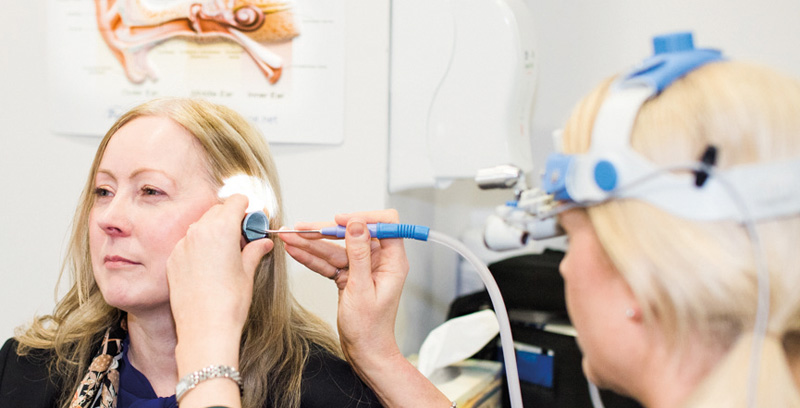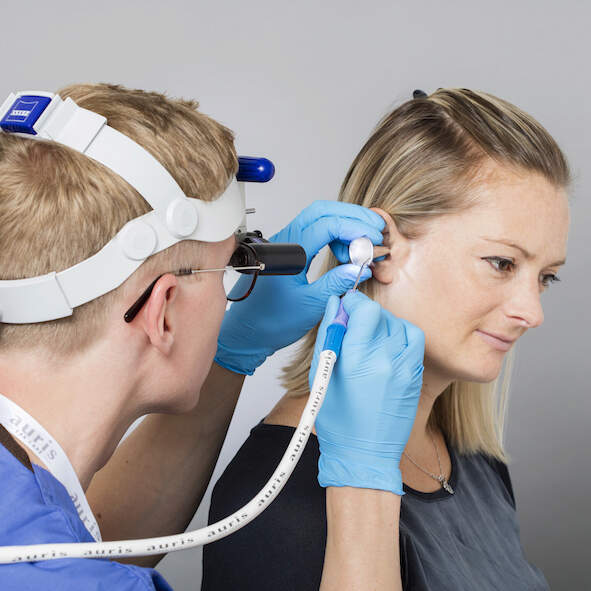
Earwax Removal Norwich
Microsuction Ear wax Removal Clinic, 5 Hurricane Way, The Therapy Centre, Norwich, NR6 6EZ , Phone: 0800 1 337 987

Ear wax microsuction is a procedure which uses gentle suction to remove excessive or troublesome ear wax. It is performed with the aid of a surgical microscope and a calibrated suction device, without the introduction of any materials or liquids. Ear wax microsuction is one of the safest, most effective, quickest and most comfortable methods of removing ear wax. Usually micro suction does not need pre-treatment with drops but two days of earol (clinically treated olive oil) is the best preparation. One of our audiologists will examine your ear using a microscope (either fixed or with loupes glasses) and, using a fine low pressure suction device, safely remove the blockage. Also, using a video otoscope we will show you the condition of the ear before and after the treatment.
Microsuction is a procedure which uses gentle suction to remove excessive or troublesome earwax. It is performed with the aid of an operating microscope and a finely calibrated suction device, without the introduction of any materials or liquids. You may be asked to use olive oil spray or drops for several days beforehand. This will make the treatment easier for you. Occasionally we may need to use other instruments to remove hard wax. The technique means that we can always see what we are doing and can avoid touching the skin of the sides of the ear canal which makes the process a lot more comfortable.
Unlike ear syringing or ear irrigation , where ear wax is flushed out ‘blindly’, with microscopic and microsuction ear wax removal the ear wax is being directly visualised under the microscope whilst it is being removed. This makes the procedure much quicker, safer and comfortable for the patient. Other benefits of microscopic and microsuction ear wax removal include: Microsuction is the safest technique for clearing ear wax from the ear canal. It is much safer than syringing. The microscope offers extremely magnified vision so the nurses can see extremely well, therefore they can remove wax/debris without touching the ear canal walls – a comfortable, safe procedure. The magnified view allow the ear nurse therapist to assess the ear canal and ear drum to make a diagnosis.
Using our services ensures that you have your earwax removed safely, quickly and by a person you can trust. The process is usually over in a few minutes and the majority of people find it easy and comfortable. The technique is the safest way to remove earwax as the professional can see everything they are doing during the removal.
Some clinics can perform microsuction to remove earwax. During this procedure a clinician will use a microscope to look into the ear canal and a very tiny suction device to suck out the wax. This technique can be a very safe and effective way to removing persistent blockages.
Ear microsuction is the most effective and safest form of earwax removal as it avoids touching the sensitive area around the ear canal and evades contact with the ear drum. A low pressure suction probe is used to gently and safely remove earwax. This technique of ear wax removal does not use high pressure water unlike ‘syringing’, therefore allowing microsuction to be the safest, fastest and cleanest method of choice.
Simple And Safe Microsuction Ear Cleaning Service
Micro-suction ear wax removal is one of the safest methods of ear cleaning and it is an ideal method of wax removal for people who have had a perforation to their eardrum or who have had any mid-ear surgery. Microsuction uses no water for the ear wax removal and there is no mess and little fuss. Lindsay is fully qualified and certified in carrying out this simple and effective treatment for ear wax blockages.
About our Microsuction Clinic

Clinical ear care, otherwise known as wax removal, can be very beneficial to people using hearing aids to increase the usefulness of their aids. We call wax removal clinical ear care as we are able to use a variety of techniques in one session. These techniques may not all be needed and we would try for microsuction ear wax removal first.
Ear Wax Removal/ Microsuction
Microsuction is a safe, quick and painless method of removing a build-up of ear wax in the ear canals using a medical suction pump, suction wand and an ear endoscope to enable observation by the practitioner. This sterile vacuum breaks down and removes the ear wax very gently from the canals. This method was traditionally only used in hospitals or ent clinics; however, it has now become more widely available as a service in private ear clinics. Microsuctioning is considered to be the safest and fastest method of ear wax removal by far, leaving you with clean ear canals before any air travel.
If ear drops or ear irrigation do not work, other options include: microsuction, which is a quick and comparatively painless treatment involving a small device which sucks out the wax from your ear. This is usually a safe option even if you have a damaged ear drum. An aural toilet uses a thin instrument with a hoop at one end to clean your ear and remove the wax.
Usually, microsuction does not even require pretreatment of ear drops. A fully qualified audiologist, will look into the ear canal through a binaural microscope (either fixed or with glasses) and, using a very fine suction device at low temperature, will safely remove the wax.
In addition to our established water irrigation method for ear wax removal we also provide a microsuction option to remove excess earwax. We will be happy to advise on which method will be most suitable for you and we will fully explain the pros and cons. Procedures are only carried out with your consent.
Ear wax removal by microsuction

Advanced ear wax removal techniques may not be widely available on the NHS, but where they are we will treat you as an NHS patient. In order to be treated at an NHS treatment centre you will need to be examined and referred to us for treatment by your GP or audiologist. Remember, it is your right to choose where you receive your NHS treatment and we are part of that choice – if we are not offered as a choice do not be afraid to ask for a referral to us if you would prefer to come here for treatment. Write to us via the contact form.
Ear wax removal is carried out as a day case procedure, so there is no need to stay in hospital overnight.
Ear wax and your hearing ear wax is a naturally occurring substance in healthy ears, but it’s quite common for wax to build up in the ear canal and can impair hearing. How do I know if I need ear wax removal? Sometimes you may not even know you have a wax build up or you may have a feeling of fullness in your ears, or you may have difficulty hearing. You can visit any bay audiology clinic, and we can look into your ear and tell you if you have wax that needs removing. Some people build up wax very quickly and require regular wax removal.
Microsuction is a wax removal technique using a very fine sterile suction device under a microscope. The gentle suction device is used to provide pain-free and immediate results, and whilst using the microscope the audiologist can clearly see inside the ear canal during the procedure making it an entirely controlled treatment.
Syringing is the traditional method of wax removal. It involves water being injected into the ear canal at high pressure, with the aim of trying to get behind the wax to force it out as the water seeps out of the ear canal. There are a number of problems associated with this method of wax removal: If you have any pain in your ears or any discharge from them, do not attempt any treatment at home, but see your GP. Most people tend to use ear wax softening drops as the first option for wax removal. These may soften the wax enough to aid the natural expulsion from the ear. There are many ear drops on the market. Some proprietary drops may be harsh to use, particularly if the person has sensitive skin or any skin condition such as eczema or psoriasis. Sodium bicarbonate ear drops can also be effective but again some people find them very drying.
read more →